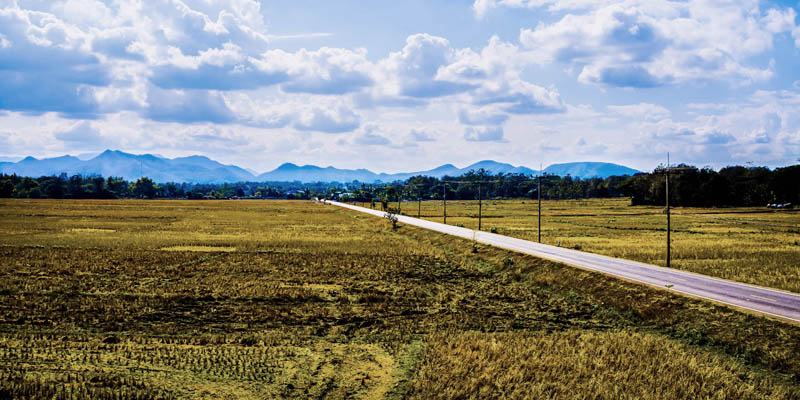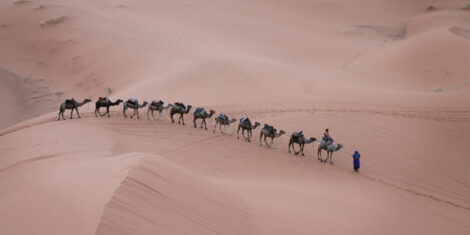We explain what a temperate climate is, and describe its characteristics and subtypes. In addition, we provide examples of plant and animal life in temperate climate regions.

What is a temperate climate?
A temperate climate is a type of climate characterized by fairly moderate monthly mean temperatures, with values above 72°F (22°C) in the warmest month, and above 32°F (0°C) in the coldest month. The annual average precipitation ranges between 24 and 79 inches (600 - 2000 mm).
Temperate climate regions typically lie between tropical and polar climate areas, meaning they are found in regions between 30° and 45° north and south latitudes, respectively. These regions experience the four seasons of the year.
Temperate climates host a wide variety of plant and animal species, and are also the most favorable type of climate for human activities. Temperate climate zones are the most densely populated areas on Earth.
- See also: Climate
Characteristics of temperate climates
Some characteristics of temperate climates are:
- Mean temperatures range between 32°F and 72°F (0°C-22°C).
- Average annual precipitation does not exceed 79 inches (2000 mm).
- The four seasons are well marked.
- They are located between 30° and 45° north and south latitudes.
- Temperate climate regions span parts of Argentina, Uruguay, and the United States in the Americas; much of Western Europe; portions of Angola and Zambia in Africa; parts of India, Laos, and China in Asia; and southern Australia and New Zealand in Oceania.
- They support the growth of a wide variety of plant and animal species.
Temperate climate types

Under the Köppen climate classification, there are three subtypes of temperate climates:
Humid temperate climate
This type of climate features evenly distributed precipitation all year round and no dry season. While rainfall is abundant, it does not exceed 98 inches (2500 mm) annually. According to temperature values, it can be classified as:
- Humid subtropical. The mean temperature of the warmest month is above 72°F (22°C).
- Temperate oceanic. The mean temperature of the warmest month is below 72°F (22°C) but above 50°F (10°C).
- Subpolar oceanic. It features less than four months of mean temperatures above 50°F (10°C) annually.
Dry-summer temperate climate (Mediterranean climate)
This climate is characterized by significantly reduced precipitation during the warmer months. It can be classified as:
- Hot-summer Mediterranean. The mean temperature of the warmest month is above 72°F (22°C).
- Oceanic Mediterranean. The mean temperature of the warmest month is below 72°F (22°C) but above 50°F (10°C).
Subhumid temperate climate (Monsoon temperate climate)
Precipitation decreases considerably during the winter while summers are rainy. It can be classified as:
- Mild summer. The mean temperature of the warmest month is below 72°F (22°C), but at least four months a year experience temperatures above 50°F (10°C).
- Subalpine. Less than two months a year experience mean temperatures above 50°F (10°C).
The Köppen climate classification identifies five major climate types: tropical, dry, temperate, continental, and polar, each of which has subtypes and differentiating features.
Distribution of temperate climates
The distribution of temperate climates on Earth is as follows:
- Humid temperate climate. It is found in parts of Argentina, Uruguay, and southern Brazil in South America; much of the Eastern United States in North America; large portions of Western Europe, particularly in France and England, as well as in parts of Spain and Germany; areas of China and Japan in Asia; and regions of Australia and New Zealand in Oceania.
- Dry-summer temperate climate (Mediterranean climate). It is located mainly near the Mediterranean Sea, in countries such as Spain, Portugal, southern France, southern Italy, Morocco, Algeria, and Tunisia. Likewise, it is found in parts of the western United States, southern Chile and Argentina in South America, and some portions of southern Australia in Oceania.
- Subhumid temperate climate (Monsoon temperate climate). It occurs in parts of Mexico and Central America in the Americas; in regions of Angola, Zambia, Zimbabwe, Malawi, Tanzania, South Africa, Ethiopia, and Madagascar in Africa; in areas of India, Bhutan, Nepal, and China in Asia; and in northern Australia in Oceania.
Flora and fauna of temperate climates

Temperate climates present favorable conditions for the development of plant and animal life. Among the main characteristics of temperate climates are:
- Flora. There are various types of grasslands, many of which have been converted into productive farmland. The temperate weather and abundant rainfall support the growth of crops such as soybeans, corn, and wheat, as well as trees like oak, conifers, and larch.
- Fauna. Dry-season temperate zones are home to a large number of animal species that have adapted to migration to avoid the colder season. Other species hibernate to survive the winter, with species including bears, squirrels, and opossums. Typical animals of temperate climates include moose, lynxes, pampas deer, bats, field mice, pumas, foxes, and birds such as cardinals and eagles.
Explore next:
References
- Meteorología en red (s.f). Clima templado. https://www.meteorologiaenred.com/
- Terrasa, D. (2018). Clasificación climática de Köppen. https://geografia.laguia2000.com/
- Valera, K. (2022). Clima templado. https://enciclopediadebiologia.com/




Was this information useful to you?
Yes NoThank you for visiting us :)